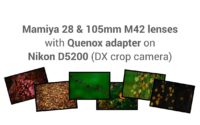Nikon D610, the underrated camera you missed?

The Nikon D610 is a very affordable all rounder that actually had too many features for the price. Most likely a knee jerk solution to the reputation risk the D600 shutter problem thrust on Nikon.
There is a bit of an ego involved with owning a camera, at least for many. The problem is that a camera is still only a tool. Most of the new stuff is becoming more and more niche in terms of problem solving. It seems the manufacturers have run out of meaningful additions.
I don’t really care about the camera in any way other than the resulting images I can achieve with it. So for me the tool must have the level of support that gives me what I need. I need a tool that is affordable and reliable.
Part of this is the need to have a camera that I can instinctively control. This takes time to establish and build a bond with the interface. So I really don’t like swapping if I can avoid it.
The Nikon D610 is a very affordable all rounder that had too many features added for the price.
#1 – D610 is Full frame 24mp
The multitude of benefits of full frame are obvious, but there are others that come with an FX Nikon system.
I have found that not only am I able to jump to 3200 iso for difficult lighting but 6400 is good too.
In addition the D610 allows the use of many of the older full frame lenses.
Samples of the Nikon D610 with various lenses can be seen in my videos.
For an article about Nikkor manual lens experiences (based around the D5200) https://alexjacksonsmith.com/2018/old-nikkor-lens-my-comparison-with-modern-lenses/
#2 – Built in Motor for older lenses
Nikon had a range of lenses that relied upon the camera body having the motor. Whilst these are slightly slower and more noisy than the modern lenses with build in motors, these older lenses are optically as good but cheaper.
On the second hand market an equivalent lens can be picked up for a fraction of the price, without any optical or image consequence.
The D610 supports them!
I have a range of lenses from old manual AIS, the AF motorises and the more modern lenses with built in motor. I am able to own lenses with lesser needed focal ranges without their cost being at premium rates.
#3 – D610 even has Dual card slots
A lot has been said about dual card slots being essential for professional work, and I would agree. Not because it is essential but because it is possible. Also worth noting is backing up in the middle of a job is a bit of a contract killer…
The Nikon D610 has two SD card slots!
Typically I have two pairs of cards all 64GB and swap them out when I need to, keeping both of the used cards on my person until I have backed them up at home. For this a solid box that stops them getting crushed is important.
#4 – Manual lenses in Aperture Priority and with EXIF data
Nikon D610 supports the old manual lenses and they are not only superb optical beasts, but they are also totally affordable. The Nikon FX digital cameras can take these old lenses directly without adapter and with all their functionality. (Only exceptions appear to be obviously auto-focus but also full automatic/shutter priority exposure modes.)
Some of the Nikon cameras (D5200 & D3300), whilst they can use the older manual lenses optically, the exposure metering is manual with no assistance. This together with the fact that EXIF data does not include details of the lens can create a problem.
The D610 does allow for up to 9 manual lenses to be “defined” in a memory and selected to add to the EXIF. More importantly the actual exposure metering recognises the aperture without digital pins or chip. This means that aperture priority and automatic exposure metering can be used painlessly.
This was a major benefit with paid event as well as artistic street photography as I am able to use the higher quality, metal build and calibrated lenses.
#5 – Depth of field preview
One of the problems with Bokeh is knowing how the effect will influence the images. The depth of field for various apertures on lenses today is a bit of a guess… In the old days manual lenses had colours for the apertures and had markers showing the delineation for the range of what would be in focus.
Looking at modern lenses such as the Nikon 35mm F 1.8, the only visual cue for depth of field is a single marker for f16! Not very useful. Depth of field preview is therefore needed if you make use of focus range for given apertures.
Using the depth of field for a given aperture is a good way of pre-preparing the camera for some street photography. This was the camera can be manually focused an avoid the focus hunting that can cause you to miss a shot.
#6 – Audio in for video
An external microphone for video is essential if the “whole” A/V result is to be professional. I am not a professional video producer by any stretch of the imagination, but the tool can do what is needed.
I use the Rode Video Mic Pro+. The settings on the internal preamp are 3/20 and the mic does the rest. It really is a magic mic.
With this combination I have found the camera pre-amp does not distort the signal.
#7 – Headphone socket for audio control
If you are serious about video work and the accompanying audio, then controlling the audio is important. A real time monitor for the volume and peaking is a must. The D610 has not only the external mic socket but also a headphone jack for monitoring the sound.
The internal amp can be changed in live view with a simple button dial combo. So the system is actually well thought through for audio control with video work.
I was recently in a church and needed to record a service with the pipe organ. This is a rather demanding contrast for an audio system. It worked and really well. I could check the sound real time to get it right.
#8 – Full coverage optical viewfinder
Users of EVFs have it good. They always have 100% view finder coverage. In the DSLR world often this is the domain of the high end cameras. Lower end cameras often supporting only 96-98% coverage.
This makes a difference when the inclusion or exclusion of something in the frame is critical to the composition. Which for the work I do it almost always is. Whilst with 24mp cropping is a viable prospect, the effort and time needed is not something that is constructive for project work.
#9 – Weather and dust sealing
For an entry level into full format to have any level of weather and dust sealing is a bit unexpected. This is perhaps only interesting to a few, for street photography or for “unfortunate” wedding photography. However it can be important if your contract depends upon it.
With weddings I guess Champagne also counts as weather as far as the camera is concerned. For street photography the ability to take shiny streets for the effects of rain. Even the atmosphere of mist and steam can be important for telling the story. Good job that with this camera you don’t have to miss-out.
#10 – D610 Quirky extra bits that I use…
Some of these are not unique but I make use of them and not all cameras have the ability.
“Spirit level”
there is an electronic level display on the camera. This can be especially useful setting up on a tripod for video work. For photography I have never used it.
“Battery Door not blocked by tripod mount”
Videoing takes more battery, partly from the setting up and checking time, but also because live view is actively powering the screen all through the recording. There is nothing more annoying than getting the talent to stop for a long time whilst undoing the tripod mount to swap the battery… then having to put it all back together again! The D610 does not have this problem.
#11 – D610 misses bits that may be a problem
“Tilty flippy screen”
This is clearly not a selfie camera, at the same time such screens are helpful for blogging or awkward photography. I did use the moving screen on my Nikon D5200 quite a lot, but the D610 does not have one and I have not missed it much, but you may!
“Total surface area focus detect”
The focus points are arranged in the field of view in a small coverage central area; much like a female sanitary product with wings… I personally use spot focus or manual focus so this has no impact on my approach. You however may need this!
“Only 6 pics a second”
I never do serial pictures so this has absolutely no effect on my work, but I know that some people do. And 6 may not be enough!
“No wifi on board”
Nikon has a weird little box that can give WIFI support. I have never needed it, but at the same time I would not use the Nikon solution as I am sure the connector would break if you are less than ultra careful when it is plugged in…!
“Not 4k video”
This camera is pre-4k times, so this is not possible. 1920×1080 is the max.
“Not quiet”
Being a DSLR it is not quiet. Not like a mirrorless. That said it is not as noisy as my Canon 5d mark 1, so in normal conditions it should not be a problem, but in a church perhaps it frightens the mice!
My Conclusion on the Nikon D610
All in all Nikon did a great job of providing a solid camera. There is not really any important feature that is missing for normal professional photographic work.
Nikon used this camera to distract from the D600 shutter problems; but at the same time they played down the D610 as a fully functional professional tool. Evidence for this is whilst it is still “on sale”; go to a professional photography outlet and finding one to compare is hard, at least in Munich! This meant the D610 did not end up taking customers away from the high-end profit products.
I guess Nikon can’t do much about it other than place it on backorder (which they have on the US website https://www.nikonusa.com/en/nikon-products/product/dslr-cameras/1540/d610.html) perhaps to frustrate people into buying a more profitable model. After all they can’t remove their entry level FX camera without opening the market to a competitor. Additionally they can replace it with something with less functionality or raise the price without suffering the public backlash.
Is this a recommendation; no. All I am saying is that manufacturers sometimes mistakenly provide in their non-top of the line models sufficient quality, functionality and ergonomics that makes the higher end far more difficult to justify. In this instance I think Nikon has done just that with the D610 and it is a reliable and powerful tool for paid video and photographic work.


